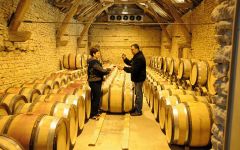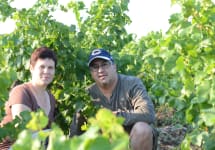Rotem & Mounir Saouma Chateauneuf-du-Pape Arioso 2016
-
Jeb
Dunnuck -
Wine
Spectator



Product Details
Your Rating
Somm Note
Winemaker Notes
Here Mounir’s whole-cluster vinification and long élèvage have combined with the immaculately ripe fruit of the 2016 harvest to create a red wine masterpiece. Layers of complex fruit flavors are balanced by a strong backbone of minerality to create a wine of great richness without s trace of excessive weight. The most Burgundian Arioso to date.
Professional Ratings
-
Jeb Dunnuck
The 2016 Châteauneuf-du-Pape Arioso is a killer wine. This cuvée is always 100% Grenache sourced from the sandy soils of the Pignan lieu-dit, which is certainly one of the great terroirs of the appellation. Sensational notes of cassis, violets, crushed rocks, and spring flowers all flow to a deep, layered, seamless 2016 that has the purity and elegance of the vintage as well as fabulous depth and richness. Elegance and purity are the buzzwords here, but it packs ample texture and concentration. It's going to benefit from short-term cellaring and be very long lived.
Barrel Sample: 96-99 -
Wine Spectator
Thoroughly beguiling from the get-go, with captivating perfume and a seductive, silky mouthfeel that serves as a canvas for the range of cassis, bitter cherry, blood orange and damson plum fruit flavors infused with rooibos, sandalwood and garrigue. There's a subtle mineral twinge at the very end. A beautiful Burgundian-style Châteauneuf.
Other Vintages
2019-
Wine
Spectator
- Vinous
-
Wine
Spectator -
Wine &
Spirits
-
Wine
Spectator - Decanter
-
Jeb
Dunnuck
-
Jeb
Dunnuck -
Wine
Spectator
-
Jeb
Dunnuck




Let’s start at the beginning: five acres in Pignan. A sale was being conducted through the French state that presented the opportunity to buy a somewhat neglected parcel adjoining some outstanding plots (notably Rayas’ Bois de Rayas and the Pignan lieu-dit). The Saoumas have long loved the area and its wines, have many friends and saw they could potentially acquire land in a way that would not be possible in Burgundy. The sheer vitality of these vines today is extraordinary.
They know and love Mounir Saouma because of the way he transmits both unknown and acknowledged great crus of Burgundy through his elevage into masterpieces, but it turns out he may be an even more talented vineyard manager. Mounir’s philosophy is in theory straightforward. He has worked to improve drainage in his vineyards, works with organic manures, and doesn’t mind the low yields he is getting in his plots. As is the case with most things in life, simplicity appears only after deliberation and experience. From this plot, Mounir has been able to acquire additional vineyards, and today farms a total of 21 acres across eight vineyards in all five villages of the appellation (Chateauneuf-du-Pape, Bedarrides, Sorgues, Courthezon, and Orange).
The kaleidoscope of the terroirs he works with is reflected in the cellar, as well, where a combination of barrels, foudres, cement, and eggs are used, all except the last of which can be considered “traditional” within the diversity of Chateauneuf’s viticultural history. The fruit is pressed firmly with small presses dating from the late 1970s, left in tank to macerate at relatively cool temperatures for 8 days, and then transferred to the various vessels. The wines are never punched down, never racked, and never sulfured until a light addition a month before bottling. They age for between 24-36 months, including the white, which as you might expect has an outsized focus here.
The wines are stunning: precise, intense, complex, expressive visions of Chateauneuf.

Grenache thrives in any warm, Mediterranean climate where ample sunlight allows its clusters to achieve full phenolic ripeness. While Grenache's birthplace is Spain (there called Garnacha), today it is more recognized as the key player in the red blends of the Southern Rhône, namely Châteauneuf-du-Pape, Côtes du Rhône and its villages. Somm Secret—The Italian island of Sardinia produces bold, rustic, single varietal Grenache (there called Cannonau). California, Washington and Australia have achieved found success with Grenache, both flying solo and in blends.

Famous for its full-bodied, seductive and spicy reds with flavor and aroma characteristics reminiscent of black cherry, baked raspberry, garrigue, olive tapenade, lavender and baking spice, Châteauneuf-du-Pape is the leading sub-appellation of the southern Rhône River Valley. Large pebbles resembling river rocks, called "galets" in French, dominate most of the terrain. The stones hold heat and reflect it back up to the low-lying gobelet-trained vines. Though the galets are typical, they are not prominent in every vineyard. Chateau Rayas is the most obvious deviation with very sandy soil.
According to law, eighteen grape varieties are allowed in Châteauneuf-du-Pape and most wines are blends of some mix of these. For reds, Grenache is the star player with Mourvedre and Syrah coming typically second. Others used include Cinsault, Counoise and occasionally Muscardin, Vaccarèse, Picquepoul Noir and Terret Noir.
Only about 6-7% of wine from Châteauneuf-du-Pape is white wine. Blends and single-varietal bottlings are typically based on the soft and floral Grenache Blanc but Clairette, Bourboulenc and Roussanne are grown with some significance.
The wine of Chateauneuf-du-Pape takes its name from the relocation of the papal court to Avignon. The lore says that after moving in 1309, Pope Clément V (after whom Chateau Pape-Clément in Pessac-Léognan is named) ordered that vines were planted. But it was actually his successor, John XXII, who established the vineyards. The name however, Chateauneuf-du-Pape, translated as "the pope's new castle," didn’t really stick until the 19th century.
